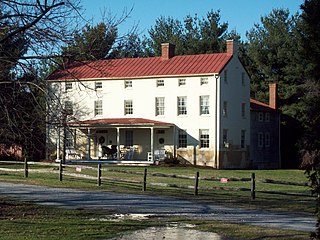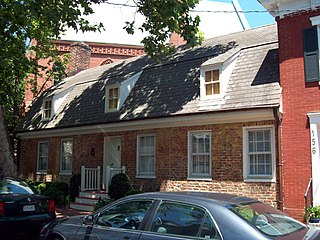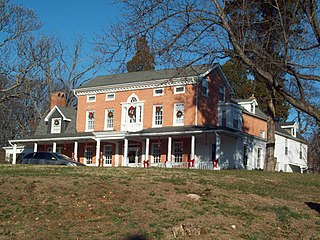
The Captain Avery Museum is a historic home and museum at Shady Side, Anne Arundel County, Maryland, United States. It is a two-story frame building, located on a 0.75-acre (3,000 m2) rectangular lot. The house overlooks the West River and Chesapeake Bay. The two-story historic structure originally was the residence of the Chesapeake Bay waterman, Capt. Salem Avery, and was constructed about 1860. It was expanded in the nineteenth century and further expanded in the 1920s by the National Masonic Fishing and Country Club. The property consists of the main house with additions, three sheds formerly used as bath houses, and a modern boathouse built in 1993 that features the Edna Florence, a locally-built 1937 Chesapeake Bay deadrise workboat.

The Benson–Hammond House is a historic house located on Poplar Avenue in Linthicum Heights, Anne Arundel County, Maryland.

Cedar Park is a historic home at Galesville, Anne Arundel County, Maryland, United States. It was originally constructed in 1702 as a 1+1⁄2-story post-in-the-ground structure, with hand-hewn timbers and riven clapboards and chimneys at either end, the earliest surviving earthfast constructed dwelling in Maryland and Virginia. Later additions and modifications, in 1736 and in the early 19th century, resulted in the brick structure of today. Also on the property is a frame tenant house or slave quarters of the mid-19th century. Between 1825 and 1834, it was an academy for young women operated by Margaret Mercer as "Miss Mercer's School."

Childs Residence, also known as the George Miller Residence and Millersville Store and Post Office, is a historic home and associated buildings at Millersville, Anne Arundel County, Maryland. The home is a c. 1840 1+1⁄2-story frame dwelling with a large 2-story frame addition built about 1852. Also on the property are a frame smokehouse/dairy built about 1840, and a c. 1920 frame store. It served as the dwelling of the first Postmaster in Millersville, and is noteworthy for having continuously served as the Post Office and community store for 130 years. It is now home to the Anne Arundel County Trails program.

The Patrick Creagh House is a historic house located at 160 Prince George Street in Annapolis, Anne Arundel County, Maryland.

Twin Oaks is a historic home at Linthicum Heights, Anne Arundel County, Maryland, United States. The house is a 2+1⁄2-story brick Greek Revival–influenced dwelling constructed in 1857, with additions and Neo-Classical embellishments made in the late 19th and early 20th centuries. The final composition is an eclectic, Georgian Revival–influenced dwelling. Twin Oaks was the home of U.S. Congressman John Charles Linthicum, who is noted for sponsoring the legislation which established The Star-Spangled Banner as the United States National Anthem. He entertained many dignitaries at Twin Oaks, including William Jennings Bryan and General Douglas MacArthur. Also on the property are a Victorian birdhouse, an aviary, a columned grape arbor, two freestanding concrete-cast columns, and a few pieces of statuary.

Evergreen is a historic home at Owensville, Anne Arundel County, Maryland, United States. It is a 2+1⁄2-story white frame house composed of several sections, the earliest of which was built about 1760, and constructed by George Neall in the Federal style. The house reflects building evolution from the third quarter of the 18th century to the late 19th century.

Oakwood is a historic house at Harwood, Anne Arundel County, Maryland. It was built in the 1850s and is a 2+1⁄2-story, frame vernacular farmhouse with Greek Revival influenced details. It is a highly intact, mid-19th-century tobacco plantation dwelling and is associated with Sprigg Harwood, a leader in the failed initiative to have Maryland leave the Union and align with the newly formed Confederate States of America.

Summer Hill is a historic home at Davidsonville, Anne Arundel County, Maryland. It is a 2+1⁄2-story frame dwelling, five bays wide and two deep. It represents a typical Maryland farmhouse of the mid 19th century. The exterior is in transition between mid-19th-century style, broadly derived from Greek Revival architecture, and an earlier style derived from Federal-Georgian sources.

Larkin's Hill Farm is a historic home at Harwood, Anne Arundel County, Maryland, United States. It is a 1+1⁄2-story gambrel-roofed brick house with a 20th-century wing. In 1683 the estate served as a temporary capital of Maryland. John Larkin, an early Quaker settler in the area, later operated an inn here as a stopping place on the first regular postal route in Maryland, which ran from St. Mary's City to Annapolis. The present brick house was built during the ownership of Lord High Sheriff of Annapolis Captain John Gassaway, the grandson of pioneer politician Colonel Nicholas Gassaway, shortly after his acquisition of the property in 1753.

Iglehart is a historic home at Iglehart, Anne Arundel County, Maryland, United States. It is a 2+1⁄2-story Greek Revival-style frame house with a gable roof, built about 1830. Its owner, Leonard Iglehart, served as a commissioner for the primary schools in Anne Arundel County from 1834 until 1838. He was also one of the six original commissioners of the Annapolis and Elk Ridge Railroad, which was incorporated by an act of the Maryland General Assembly in December 1836.

The Rising Sun Inn is a historic home in Anne Arundel County, Maryland, United States. It is a mid- and late-18th-century 1+1⁄2-story frame house. The earlier section dates to about 1753 and is covered with a gable roof and features a brick gable end. In the late 18th century, a frame, one-room gambrel roof wing was added to the northwest gable end of the house. Since 1916, it has been used as the headquarters of the Ann Arundel Chapter of the Daughters of the American Revolution.

Anne Arundel County Free School is a historic school building at Davidsonville, Anne Arundel County, Maryland. The first Free School of Anne Arundel County was established by an Act of the General Assembly of colonial Maryland in 1723. It was built somewhere between its contractual date of 1724 and 1746 when it was under full operation with John Wilmot as schoolmaster. The existing abandoned building is 49' x 18', and consists of six rooms on two floors. It was built "as near the center of the county as may be, and as may be the most convenient for the boarding of children." The county then included what is now Howard County. It remained in operation until 1912 when the movement toward consolidation forced the closure of many early school buildings. It is the only surviving schoolhouse erected in Maryland in response to the Maryland Free School Act of 1723.

Stanton Center is a historic building at Annapolis, Anne Arundel County, Maryland, United States. It is a two-story, Classical Revival brick masonry building with a one-story addition. It is the second school building on the site and was first used as an elementary school and later became the first high school for African Americans in Anne Arundel County. It remained in use as a school until the desegregation of the Anne Arundel County school system in the 1960s, when it became a community center.

Tracy's Landing Tobacco House No. 2 is a historic tobacco barn at Tracy's Landing, Anne Arundel County, Maryland. It is a 24’3" by 45’2" heavy timber framed tobacco barn with a construction date of 1805. It is the earliest identified tobacco house extant in Anne Arundel County, and is one of the earliest recorded examples of this type of agricultural building in Tidewater Maryland.

Davidsonville Historic District is a national historic district at Davidsonville, Anne Arundel County, Maryland. It is located around a rural crossroads at the intersection of Central Avenue and Davidsonville Road. The district consists of fifteen properties: three churches, one commercial building, and eleven houses. They represent the period from the village's initial settlement in about 1835 through the early 20th century.

Owensville Historic District is a national historic district at Owensville, Anne Arundel County, Maryland. It is located around a small crossroads community located at the intersection of Owensville Road and Owensville-Sudley Road. It consists of a concentration of historic buildings leading up to and clustered around the intersecting roads. It consists of 27 buildings, including two church complexes, 16 dwellings with their associated domestic outbuildings, and several agricultural buildings, including tobacco barns. Included in the district is the separately listed Christ Church. Much of the historic building stock dates between 1825 and 1875.

Woodwardville Historic District is a national historic district at Woodwardville, Anne Arundel County, Maryland. The district consists of 16 historic structures, most of which are located adjacent to Patuxent Road, which runs through the center of the village of Woodwardville. The district contains good examples of late-19th and early-20th century domestic architecture, including Bungalow, Foursquare, Tudor Revival, and Queen Anne styles. The village's development was directly related to the construction of the Baltimore & Potomac Railroad, initiated in 1867 and completed in 1872.
Quarter Place is a historic home located at Lothian in Anne Arundel County, Maryland, United States. It was built in 1860 and is a 2+1⁄2-story Gothic Revival–style frame dwelling. It consists of a main block with a 2-story rear wing. The main block is three bays wide with a central entrance and features a central cross-gable roof.

Robinson House is a historic home located at Severna Park in Anne Arundel County, Maryland, United States. It was built about 1740 and is a 1+1⁄2-story stone dwelling with a gambrel roof, 40 feet wide by 24 feet deep. It is built of red sandstone, locally known as ironstone.























